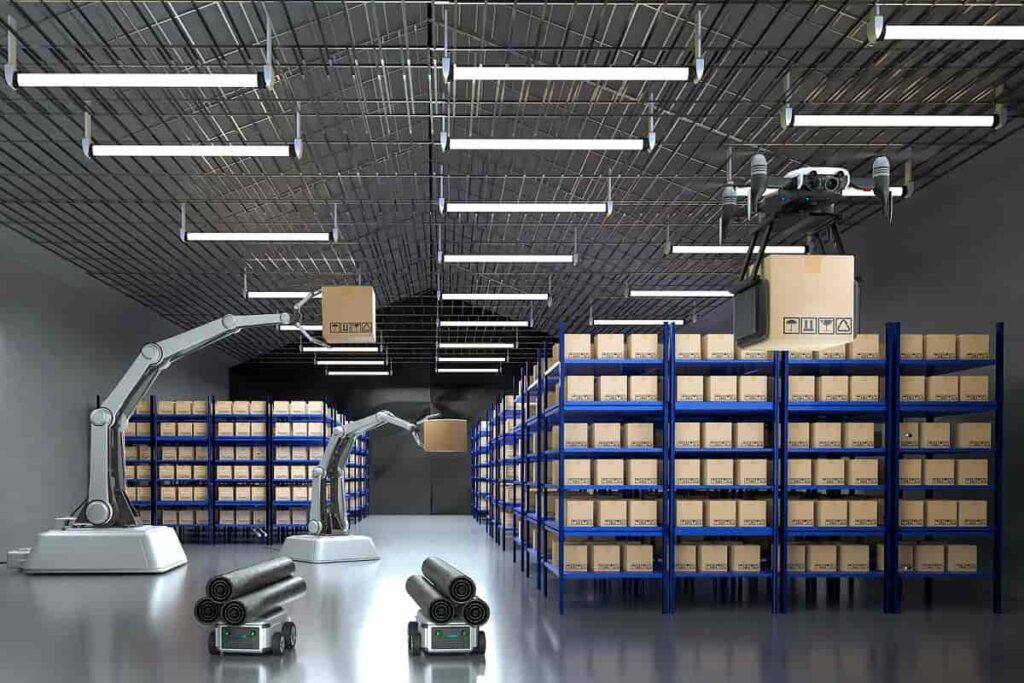Shoplifting Prevention Technologies for Retailers
Table of contents

Shoplifting comes in many shapes and forms, from the broke pre-teen who is about to learn a valuable life lesson to a sophisticated gang of criminals that brazenly robs stores right in front of security cameras. In whatever form it ends up taking, shoplifting is when someone takes something from a store without paying for it – intentionally or not. (Parents will understand why we added that last bit.) And shoplifting has the capacity to affect every single retail business, with 1 in 11 people that walk into a store – 27 million – being considered shoplifters in the United States alone. With the average cost of every shoplifting incident reaching $559, it’s no wonder that inventory shrinkage is damaging the US retail industry with losses amounting to more than $45 billion every year.

The act of combating shoplifters is often referred to as “loss prevention,” and it’s something that the retail industry spends about $4 billion a year on. For bricks-and-mortar stores, loss prevention usually means employing “undercover shoppers” who are actually security guards, or having humans actively watching cameras to identify theft in progress. Unfortunately, these initiatives seem to be failing, as shoplifters claim that for every 48 times they go out and steal, they only get caught an average of one time. In fact, 60% of identified shoplifters were recorded visiting at least two other locations of the same retail chain with 20% going to three or more branches. Check out these popular internet searches we uncovered using our SEO tool:
Let’s look at 11 companies that are utilizing technology to prevent shoplifting in brick-and-mortar stores.
Looking for Suspicious Behavior
Founded in 2017, Tokyo startup Vaak has taken in $500,000 in funding so far to develop software called VAAKEYE. Unlike other systems that match faces to criminal records, this software analyzes a person’s behavior to predict criminal action. According to company founder Ryo Tanaka, his team utilized 100,000 hours of surveillance data in creating their algorithm.

Doing so helped them train the system to analyze everything ranging from the facial expressions of every shopper to their actions and clothing. Vaak started out by taking $450,000 in funding from SoftBank ‘s AI fund, and is in the middle raising a Series A round which is said to be around $9 million. So far, VAAKEYE has been rolled out to 50 locations in Tokyo, with the company claiming a 77% decrease in shoplifting at local convenience stores during their trial period. Shoplifting awareness has certainly skyrocketed in Japan after last year’s critically acclaimed Japanese film “Shoplifters” which has been winning awards left and right.
Tracing Generic Assets


To remedy this situation, the company uses an aerosol canister containing metallic DataDots which are sprayed or brushed on different parts of the equipment. These dots are almost invisible to the naked eye but can be spotted using UV light and a magnifying device. Tracking them is convenient as well since each DataDot has a unique code registered to the company owner via the Global DataDot Database.
Return Fraud
Founded in 2006, New Jersey startup Agilence has taken in $29 million in funding so far to develop Retail 20/20, a store-level reporting solution that allows business owners to closely monitor day-to-day operations. One feature of their system is the ability to identify fraudulent transactions. While the majority of loss prevention jobs focus on catching shoplifters, Agilence’s technology concentrates on return frauds. These scams can take all kind of forms, including the following five types:

Since its system provides an omnipresent capacity for store owners, it also allows them to easily detect and track the activities of their staff and the behavior of customers across multiple stores. Some Agilence clients include Bath and Body Works, Jockey, and Kirkland.
Curbing Push-out Theft

The company utilizes a digitally encoded RF locking system complemented by a wheel-locking feature called purchek. This combination of solutions can automatically halt the movement of shopping carts containing unpaid items that attempt to leave the store. This is used to combat “push-out theft” which is why that person at Costco checks your receipt when you try to exit the store.
Security Tags for Self-checkout
Founded in 2015, Brooklyn startup QueueHop has taken in $120,000 in funding so far to develop an RFID anti-theft apparel security tag that automatically unlocks once the customer pays for the item. This allows for security tags to be removed as part of a self-checkout system where a human shouldn’t have to use some awkward-to-use apparatus for removing security tags from expensive items. Since 2016, the company has been working with luxury handbag designer and retailer Rebecca Minkoff to protect some big-ticket items in their stores in SoHo. In 2017, QueueHop established a partnership with Guangzhou startup TrustTag to expand their security tag solutions.
What’s Making it Beep?
Founded in 2011, Barcelona startup Keonn Technologies has taken in $500,000 in funding so far to develop a retail loss prevention system called AdvanSafe. This anti-theft solution offers an unobtrusive way of preventing theft in stores. The AdvanSafe-200 has a UHF antenna designed with an embedded reader and alarm that functions as both EAS and RFID. The system can detect the items that pass below the antenna and verifies if these have already been paid. If not, the system triggers an alarm to alert the store staff of the theft.
Once the system detects a stolen item, the staff will be notified via the AdvanCloud. Unlike other systems, Keonn’s products specify which items were stolen instead of the personnel going through each product in the suspect’s bag. (We’ve all probably dealt with this embarrassing process at one time or another.) The pertinent information will be sent to store employees along with other key information to help them easily identify which of the things are being stolen – or not.
It Never Forgets a Face
Founded in 2012, startup FaceFirst is one of the top-funded facial recognition startups today. So far, it has taken in $9.5 million in funding to develop a platform that utilizes face recognition technology to stop fraud as well as avoid security risks and public safety threats. The facial recognition software can automatically generate real-time alerts whenever a particular face matches a user-defined probability.

Generally, the software recognizes people with prior arrest records, suspected shoplifters, and other persons of interest who are included in the internal watch/ban lists of particular stores. Once the system detects a person matching the criteria set on its system, it’ll immediately alert the store employees. To ensure that dishonest customers do not hit additional stores, FaceFirst offers a shared intelligence network containing the threats already detected in other establishments across the globe.
Helping the Humans
Founded in 2015, Denver startup DeepCam has taken in $20 million in funding so far to develop “Retail by DeepCam,” a plug-and-play system that complements loss prevention workers in bricks-and-mortar stores. Similar to FaceFirst, this computer vision company focuses on facial recognition along with gesture and object recognition.

The facial recognition capacity of the system ensures that the known shoplifters already recorded in the system are deterred from entering the store. Meanwhile, behavioral analytics help store personnel tag suspected shoplifters and alert the team to keep a closer watch. The DeepCam AI platform will be available as a subscription service for only $99 per month, or at a discounted rate of $999 per year. Subscription pricing includes hardware and any hardware upgrades, eliminating tech change and upgrade fees.
Liquidity Events for Loss Prevention Startups
So far we’ve discussed eight startups that are developing technologies, and the investors behind those startups will be excited to learn about some recent liquidity events surrounding shoplifting technology startups. Let’s look at a few of them.
Founded in 2008, New Jersey startup Checkpoint Systems “provides the most innovative and technically advanced products engineered to protect high-theft merchandise.” Essentially, they provide a platform that provides varying degrees of protection based on a product’s value. For example, their Mini NeedleLok solution ensures that detection devices can be attached to fine garments without damaging them with pinholes. Checkpoint Systems is used by some of the world’s biggest retailers including names like Walgreens and Walmart, and was acquired by Canadian firm CCL Industries (CCL/B:CN) – the world’s largest label maker – for $443 million in 2016.
Founded in 2003, Cambridge startup StopLift Checkout Vision System developed an AI system that can visually analyze CCTV footage to detect possible thefts particularly involving cashiers and customers. Known as one of the pioneers of checkout vision systems, StopLift has zeroed in on detecting “sweethearting” between cashiers and customers.
“Sweethearting” is the illegal giving away of store items free of charge to a “sweetheart” buyer like a friend, family member, or even a fellow employee. It’s a problem that costs the retail industry roughly $14 billion in lost funds annually. The cheating is done at the counter when the cashier fake scans or fake rings up the merchandise – usually by covering the barcode while pretending to run the item through the machine or leaving the unscanned items in the cart then bagging them later. Last year, StopLift was acquired by NCR Corporation (NCR), a publicly traded company that specializes in transaction technologies like self-checkout systems or point-of-sale systems. Details of the transaction were undisclosed.
Conclusion
Using technology for shoplifting prevention is a win-win for retailers. Reducing theft impacts a retailer’s margins in a number of ways, the most obvious being that products that are already paid for don’t just disappear from inventory. Technology can be used to replace loss prevention jobs where humans who are physically incapable of catching but a small sliver of the problems by using the human eye. An eye in the sky might be the answer, though there now appears to be regulatory risk around business models that plan to use facial identification. Regardless, there is definitely an appetite for startups who are solving the shoplifting problem using the latest technologies. And this is hardly an exhaustive list of shoplifting prevention technologies out there. If your startup is using technology to combat shoplifting and we “missed you,” drop us a comment below and tell our readers what you’re up to.
Sign up to our newsletter to get more of our great research delivered straight to your inbox!
Nanalyze Weekly includes useful insights written by our team of underpaid MBAs, research on new disruptive technology stocks flying under the radar, and summaries of our recent research. Always 100% free.















